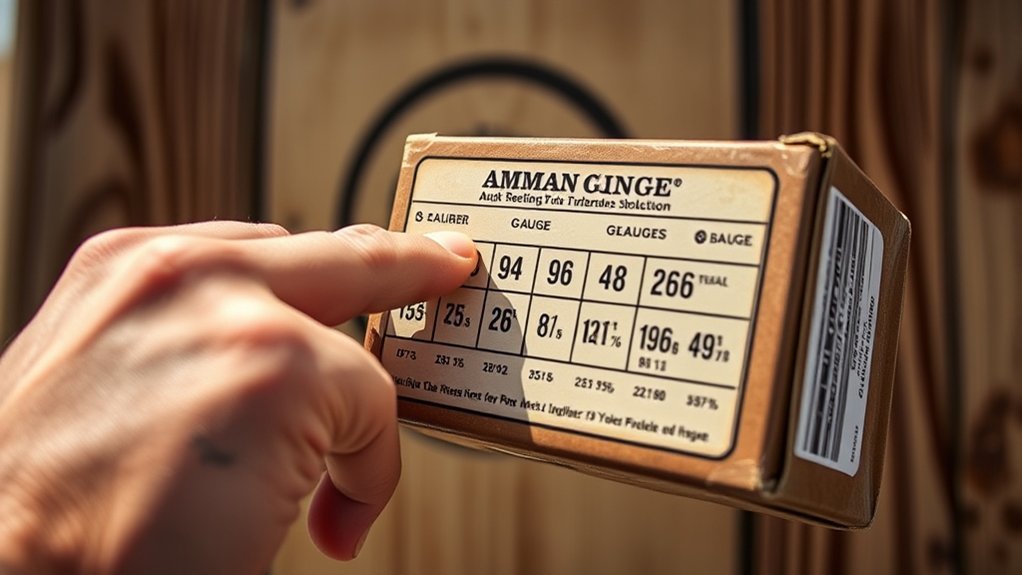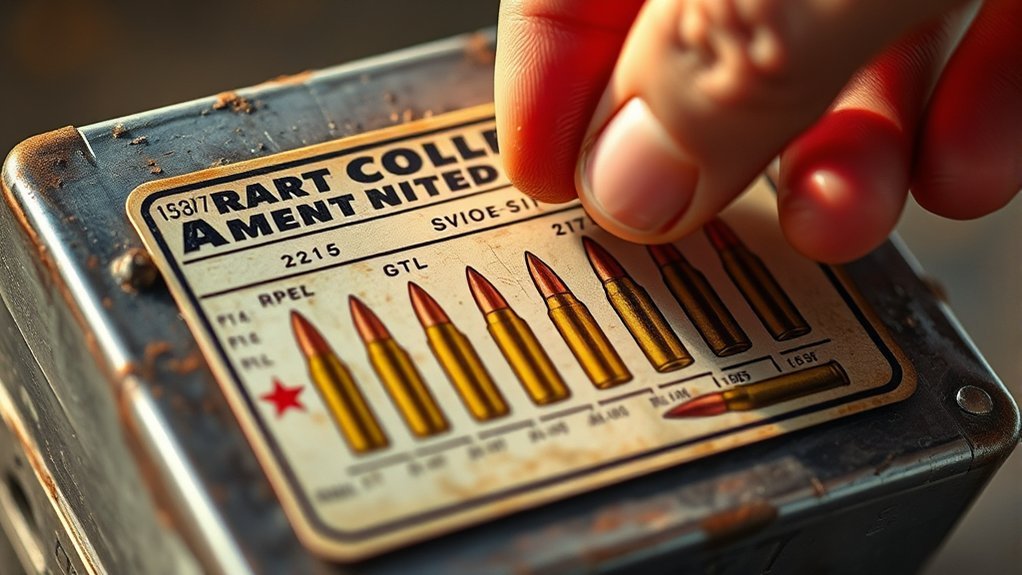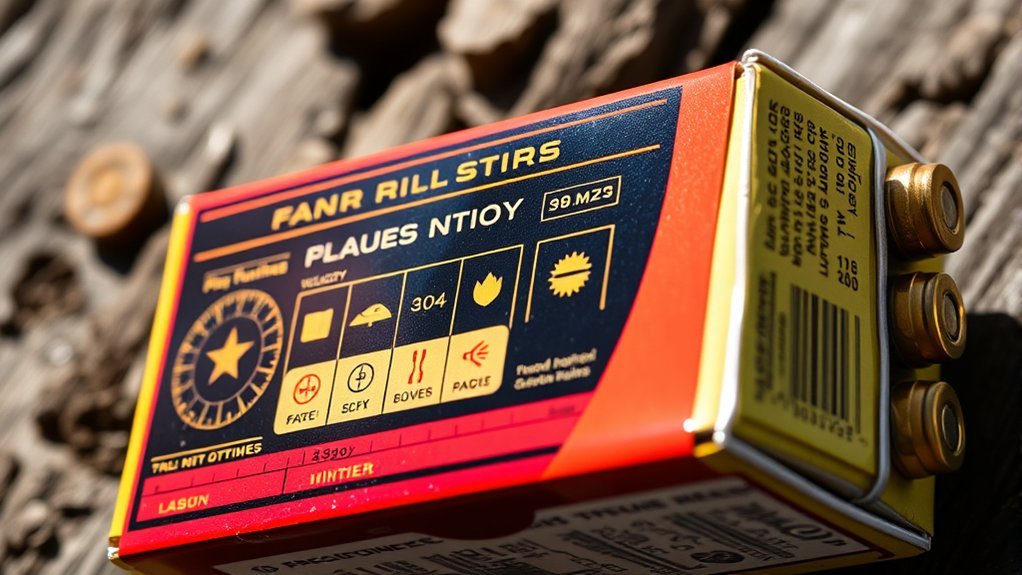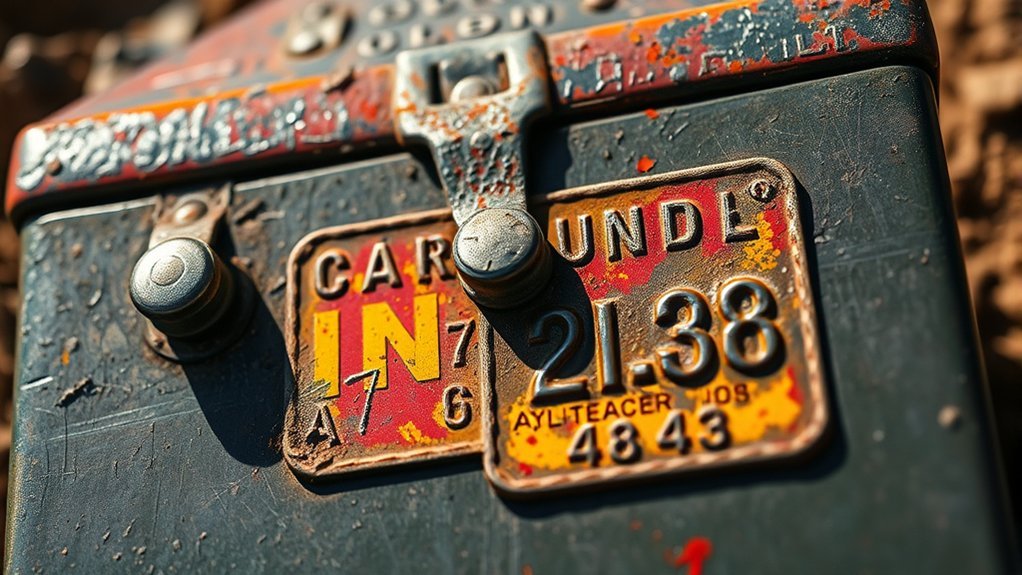When you pick up an ammo box, it’s essential to understand the label. You’ll find important details like caliber, bullet type, and grain weight that directly impact your shooting experience. Each element plays a role in compatibility and performance. Ignoring these specifics can lead to issues down the line. So, what should you look for first? Let’s break it down step by step to guarantee you’re properly equipped.
Understanding Caliber and Gauge

When you pick up an ammo box, understanding caliber and gauge is crucial for making the right choice. Caliber refers to the diameter of the bullet and is typically measured in inches or millimeters. For instance, a .45 caliber bullet has a diameter of .45 inches, while a 9mm bullet measures 9 millimeters. Gauge, on the other hand, applies mainly to shotguns and indicates the size of the shotgun bore. The lower the gauge number, the larger the bore; for example, a 12-gauge shotgun is larger than a 20-gauge. Knowing the right caliber or gauge guarantees you select ammunition compatible with your firearm, enhancing safety and performance during use. Always double-check your weapon’s specifications before purchasing.
Bullet Type and Designation

When you look at an ammo box label, understanding bullet type and designation is essential. Different bullet types, like hollow points or full metal jackets, serve specific purposes, and the designation codes help identify these characteristics. Knowing what each type means can enhance your shooting experience and guarantee you choose the right ammo for your needs.
Common Bullet Types
Understanding common bullet types and their designations is essential for selecting the right ammunition for your needs. Each type serves a specific purpose, enhancing your shooting experience. Here are four common bullet types you should know:
- Full Metal Jacket (FMJ): Ideal for target practice, FMJs are designed to reduce barrel fouling and improve accuracy.
- Hollow Point (HP): These bullets expand upon impact, making them excellent for self-defense and hunting.
- Soft Point (SP): SP bullets offer controlled expansion and are often used for hunting larger game.
- Boat Tail (BT): With a tapered rear, BT bullets improve aerodynamics, resulting in better long-range performance.
Knowing these types helps you choose the right ammo for your shooting activities.
Designation Codes Explained
Decoding ammunition designation codes can seem intimidating, but it’s crucial for choosing the right bullet. Each code typically includes information about the bullet type, caliber, and design. For example, a designation like “5.56x45mm NATO” indicates the caliber and case length. Bullet types, such as FMJ (Full Metal Jacket), HP (Hollow Point), or SP (Soft Point), describe their intended use.
Understanding these codes helps you select ammunition suited for specific purposes, whether it’s target shooting, hunting, or self-defense. Look for additional specifications like weight in grains, which affects performance. Familiarizing yourself with these designations guarantees you make informed choices, enhancing both accuracy and safety in your shooting experience.
Velocity and Energy Ratings

When you look at an ammo box label, pay close attention to the velocity numbers and energy values listed. These ratings can tell you a lot about how the ammunition will perform in real-world scenarios. Understanding these figures helps you choose the right ammo for your needs.
Understanding Velocity Numbers
Velocity numbers on an ammo box label are essential for evaluating a cartridge’s performance. They indicate how fast a bullet travels when fired, which affects accuracy and terminal performance. Understanding these numbers helps you choose the right ammunition for your needs. Here are some key points to take into account:
- Measurement: Velocity is usually measured in feet per second (FPS).
- Impact: Higher velocities often lead to flatter trajectories.
- Ballistics: Velocity influences bullet drop and wind drift.
- Applications: Different uses, like hunting or target shooting, may require specific velocity ranges.
Interpreting Energy Values
How can you effectively assess the performance of ammunition? By understanding energy values, you can gauge how much power a round delivers upon firing. Energy is typically expressed in foot-pounds or joules and is calculated using the bullet’s weight and velocity. When you see an energy rating on the box, it indicates the kinetic energy the bullet will have at a certain distance. This value helps you compare different loads and choose the right one for your needs. Higher energy values often suggest greater stopping power, but it is crucial to match that with your intended use. Always consider both velocity and energy ratings to make informed decisions about your ammunition.
Impact on Performance
Understanding the impact of velocity and energy ratings on performance is essential for selecting the right ammunition. These ratings directly influence how your ammunition behaves, affecting everything from accuracy to stopping power. Here are some key points to evaluate:
- Velocity: Higher speeds can lead to flatter trajectories and reduced wind drift.
- Energy: Greater energy translates to more stopping power upon impact.
- Bullet Design: Different designs perform better at specific velocities and energy levels.
- Application: Match your ammo’s performance with its intended use, whether for target shooting or hunting.
Grain Weight and Its Importance
When it comes to ammunition, grain weight plays a crucial role in determining performance. The grain measurement refers to the bullet’s weight, with one grain equal to 1/7000th of a pound. Generally, lighter bullets (around 55 grains) offer higher velocities and flatter trajectories, making them suitable for varmint hunting or target shooting. Heavier bullets (like 180 grains) deliver more energy upon impact, which is ideal for larger game or self-defense situations. Choosing the right grain weight affects your accuracy, recoil, and overall effectiveness. It’s essential to match the grain weight with your firearm’s specifications and your shooting goals. By understanding grain weight, you can make informed decisions and enhance your shooting experience.
Types of Ammunition (Rimfire vs. Centerfire)
Ammunition comes in two primary types: rimfire and centerfire, each with distinct characteristics and uses. Understanding these differences helps you choose the right ammo for your needs.
Ammunition is categorized into rimfire and centerfire, each serving unique purposes and offering different advantages.
- Rimfire: Primarily used in .22 caliber firearms, it features a primer located in the rim of the cartridge.
- Centerfire: Commonly used in handguns and rifles, it has a primer located in the center of the cartridge base.
- Recoil: Rimfire cartridges typically produce less recoil, making them ideal for beginners.
- Cost: Rimfire ammo is generally more affordable than centerfire options, allowing for more practice without breaking the bank.
Manufacturer and Lot Number
Knowing the type of ammunition you’re using is just the beginning. Next, you should pay attention to the manufacturer and lot number printed on the box. The manufacturer’s name tells you who produced the ammunition, which can be essential for quality assurance and consistency. Familiarizing yourself with reputable brands can help you make informed choices.
The lot number is equally important; it identifies a specific batch of ammunition. This number can be useful for tracking any potential issues, such as recalls or performance inconsistencies. If you experience a problem with your ammo, having the lot number handy allows you to report it accurately. Always keep this information in mind to guarantee you’re using reliable ammunition for your shooting needs.
Safety Warnings and Recommendations
While you’re examining the ammo box, don’t overlook the safety warnings and recommendations provided by the manufacturer. These essential guidelines guarantee your safety and the proper use of the ammunition. Here are some key points to keep in mind:
- Always keep ammunition away from heat sources and moisture.
- Use appropriate firearms as specified for the ammo type.
- Store ammo in a cool, dry place, ideally in a locked cabinet.
- Follow local laws and regulations regarding ammunition use and storage.
Packaging and Storage Information
When you look at an ammo box, the packaging and storage information is essential for guaranteeing the ammunition remains effective and safe to use. Proper storage helps prevent moisture, temperature fluctuations, and physical damage. Always read the label for specific instructions.
Here’s a quick guide to common packaging and storage details:
| Storage Condition | Recommended Temp | Humidity Level |
|---|---|---|
| Ideal for Long-Term | 60-70°F | 30-50% |
| Short-Term Storage | 70-85°F | Below 70% |
| Avoid Extreme Heat | Above 100°F | N/A |
| Moisture Protection | Sealed Containers | Use Desiccants |
| Store Upright | N/A | N/A |
Following these guidelines guarantees your ammunition stays in top condition.
Conclusion
So, there you have it! Reading an ammo box label isn’t rocket science—though it might feel like it when you’re staring at a jumble of numbers and letters. Just remember, choosing the right ammo is vital, unless you enjoy the thrill of a misfire or an unintended fireworks display. Be smart, stay safe, and don’t let your ammunition decisions be as confusing as deciphering your in-laws’ holiday card. Happy shooting, and may your bullets always find their mark!

